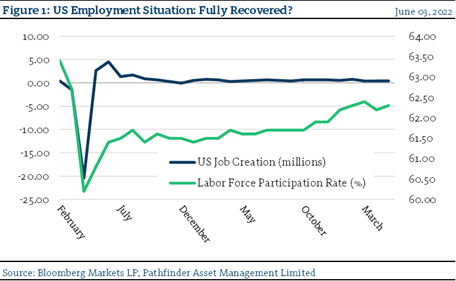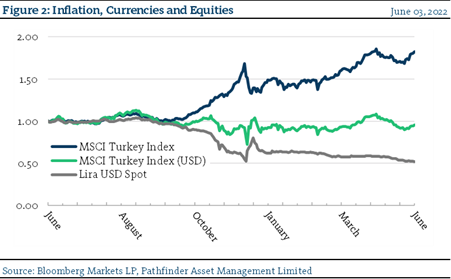Employment and Turkey
This morning, during our daily desk chat, there were two topics of conversation that we thought worth mentioning. The first was the US Non-Farm Payrolls (“Jobs”) Report and the second was Turkey. The Jobs Report is useful for tracking the employment situation in the US. Given that consumer spending is two third of US GDP, it is also a good barometer for the US economy. We noted that the street view is somewhat pessimistic. Also, this morning, there were a number of big headlines concerning job cuts, including a memo from Tesla Inc. CEO Elon Musk that they will cut their workforce by 10%. The second topic was inflation and the huge year-on-year CPI print in Turkey (73.5%). This sparked a lively discussion amongst the investment team.
- The US added 390k jobs last month, which was better than expected. When the pandemic hit, 1.5 million jobs were lost in the first month and another 20.5 million in the second. After the stimulus was enacted, two years later, 21.2 million jobs have been created, recovering most of the losses from COVID mitigation measures. However, we are not totally back to normal as the participation rate is lower (Figure 1) and wages are now materially increasing.

- Figure 2 shows the situation in Turkey, which we present as a live example of how runaway inflation and poor governance can impair an economy. Note that the stock market in local currency terms has doubled over the past year, but when one takes in the depreciation of the currency into account, there has been no change. The Central bank there is not independent, and their President has refused to increase interest rates to combat inflation. Thus, the currency had deprecated against all other major countries. This will not end well for them.

“This means that” while economies continue to recover, there are major implications from the substantial global changes that we are now experiencing (supply chain, global central back actions, China COVID mitigation efforts, war). Ultimately, this will take some time to play out and we should expect more volatility.
National Instrument 31-103 requires registered firms to disclose information that a reasonable investor would expect to know, including any material conflicts with the firm or its representatives. Doug Johnson and/or Pathfinder Asset Management Limited are an insider of companies periodically mentioned in this report. Please visit www.paml.ca for full disclosures.
*All returns are time weighted and net of investment management fees. Returns from the Pathfinder Partners’ Fund and Partners’ Real Return Plus Fund are presented based on the masters series of each fund. The Pathfinder Core: Equity Portfolio and The Pathfinder Core: High Income Portfolio are live accounts. These are actual accounts owned by the Pathfinder Chairman (Equity) and client (High Income) which contain no legacy positions, cash flows or other Pathfinder investment mandates or products. Monthly inception dates for each fund and portfolio are as follows: Pathfinder Core: Equity Portfolio (January 2011), Pathfinder Core: High Income Portfolio (October 2012) Partners’ Fund (April 2011), Partners’ Real Return Plus Fund (April, 2013), and Partners’ Core Plus Fund (November 2014).
Pathfinder Asset Management Limited (PAML) and its affiliates may collectively beneficially own in excess of 10% of one or more classes of the issued and outstanding equity securities mentioned in this newsletter. This publication is intended only to convey information. It is not to be construed as an investment guide or as an offer or solicitation of an offer to buy or sell any of the securities mentioned in it. The author has taken all usual and reasonable precautions to determine that the information contained in this publication has been obtained from sources believed to be reliable and that the procedures used to summarize and analyze such information are based on approved practices and principles in the investment industry. However, the market forces underlying investment value are subject to sudden and dramatic changes and data availability varies from one moment to the next. Consequently, neither the author nor PAML can make any warranty as to the accuracy or completeness of information, analysis or views contained in this publication or their usefulness or suitability in any particular circumstance. You should not undertake any investment or portfolio assessment or other transaction on the basis of this publication, but should first consult your portfolio manager, who can assess all relevant particulars of any proposed investment or transaction. PAML and the author accept no liability of any kind whatsoever or any damages or losses incurred by you as a result of reliance upon or use of this publication.